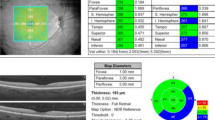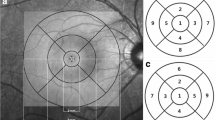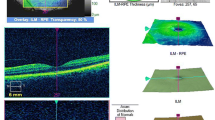Abstract
Purpose
To examine healthy subjects for normal macular thickness values and determine the effects of gender and age in a Turkish population, using spectral optical coherence tomography/scanning laser ophthalmoscopy (OCT/SLO).
Material and method
Six hundred fourteen eyes of 307 subjects with no history of ocular diseases and normal ophthalmic examination were recruited in this cross-sectional, prospective study. The participants were divided into three groups based on age (between 20 and 29 years: group 1, between 30 and 39 years: group 2, between 40 and 49 years: group 3). All subjects were scanned with spectral OCT/SLO, performed by one examiner to acquire the retinal thickness map in the ETDRS grid, and values were recorded for nine sectors, and effects of age and gender were evaluated.
Results
When all the subjects were evaluated, the thicknesses were lower in women than men in all sectors (p < 0.001). When divided in groups based on age, this difference remained only in the outer segments. However, the differences in outer layers, except outer nasal layer, were thicker in women in group 3 when compared to others in group 3. When compared between groups, only central thickness in group 3 was shown to be higher than group 1 (p = 0.06). There was no significant difference of thicknesses in any sector when compared right and left eyes of all subjects.
Conclusions
The study reports the variation in retinal thickness between age and gender in a relatively large sample of a Turkish population. It is important to consider these effects while interpreting the OCT images to make an appropriate diagnosis in retinal diseases.
Similar content being viewed by others
Explore related subjects
Discover the latest articles, news and stories from top researchers in related subjects.Avoid common mistakes on your manuscript.
Introduction
In recent years, optical coherence tomography (OCT) has become an essential tool in ophthalmology to diagnose macular diseases, especially edema caused by diabetes or retinal vein occlusion, neovascular membranes, or macular atrophy caused by age-related macular degeneration, which are among the most common causes of decreased visual acuity in the world. OCT is a noninvasive technique to asses the retinal structures and to follow the medical or surgical treatment results of macular diseases in vivo with high-resolution images [1]. Therefore, it is important to determine the normal values and demographic variations of retinal thickness in healthy population to detect the abnormalities and diagnose retinal diseases correctly.
In a study by Asrani et al. [2], with a retinal thickness analyzer, the effects of gender and race on retinal thickness have been shown, whereas no relationship between age and retinal thickness has been found. Until recently, several studies have been performed in healthy subjects and found different results in relation of age and gender between macular thickness with different OCT devices [3–15].
In this study, we aim to examine healthy subjects for normal macular thickness values and determine the effects of gender and age in a Turkish population, using Spectral OCT/SLO.
Methods
Six hundred fourteen eyes of 307 subjects, evaluated in the ophthalmology clinic of a tertiary care center in South of Turkey between January 2014 and August 2015, were recruited in this cross-sectional, prospective study. All participants underwent a comprehensive ocular examination, including visual acuity, slit-lamp examination, Goldmann applanation tonometry, and indirect ophthalmoscopy with a 90D lens. The healthy subjects with no history of ocular disease, visual acuity of 20/40 or better, repeated intraocular pressure (IOP) readings <21 mmHg, and normal appearing optic nerve and macula were included in the study. The subjects with IOP >21 mmHg, any sign or previous diagnosis of uveitis or retinal disease, history of ocular trauma or systemic diseases such as autoimmun, or history of malignancy, severe systemic hypertension or diabetes mellitus, and severe cataract resulting poor image quality were excluded. The participants were divided into three groups based on age (between 20 and 29 years: group 1, between 30 and 39 years: group 2, between 40 and 49 years: group 3). Informed consent was obtained from all participants. The study was approved by local ethics review board and adhered to the tenets of the Declaration of Helsinki.
After pupil dilation with 1% tropicamide Spectral OCT/SLO (OPKO/OTI, Miami, FL, USA), using 27000 A-scans per second was performed by one examiner to acquire the retinal thickness map in the ETDRS grid (6 × 6 mm) produced by the built-in software. The values were recorded for nine sectors; inner ring with a diameter of 1500 µm and outer ring with a diameter of 3000 µm. These rings were also divided into four sectors; superior, nasal, inferior, and temporal. The central sector was defined as being within 1000 µm of the center of the fovea [13].
Statistical analysis was performed by using SPSS for Windows 16.0 (SPSS Inc. Chicago, USA). The Kolmogorov–Smirnov test was used to check normal distribution of variables. All the numerical variables were compared using one-way ANOVA and multivariate variance analysis tests. The descriptive statistics were expressed as mean ± SD. Qualitative variables were compared with Chi square test. A p value less than 0.05 was considered statistically significant.
Results
The study recruited both eyes of 307 healthy subjects, divided into three groups. Group 1 included subjects of ages between 20 and 29 years (n = 104, 40 males, 64 females), group 2 of ages between 30 and 39 years (n = 84, 41 males, 43 females), and group 3 of ages between 40 and 49 years (n = 119, 51 males, 68 females). No significant difference in gender within or between groups was found. IOP values were found to be significantly low in group 1 when compared to others (14.34 vs. 15.42 and 15.40, p < 0.001).
When all subjects were evaluated, the thicknesses were lower in women than men in all sectors (p < 0.001) (Table 1). When divided in groups based on age, this difference remained only in the outer segments. However, the differences in outer layers, except outer nasal layer, were thicker in women in group 3 when compared to others (Table 2).
When compared between groups, only central thickness in group 3 was shown to be higher than group 1 (p = 0.06) (Table 3).
There was no significant difference of thicknesses in any sector when compared right and left eyes of all subjects.
Discussion
Optical coherence tomography is almost a routine part of an ocular examination, especially in retina departments, to detect the abnormalities of macula. Over the years, many advances in OCT devices made it possible to capture images with high resolution with faster imaging systems, demanding normative data, and demographic variations for the measurements of these devices for different populations. Although several studies in this matter have been reported, as far as to the best of our knowledge, this study is the first in a relatively large sample of Turkish population.
In this study, we found that in all sectors including the central sector, the retinal thickness is significantly higher in men than in women. This finding is consistent with most of the previous studies [3–10, 12, 13, 15–17]. In a study by Adhi et al. [10], it is found that the retinal thickness was greater in men than in women in all sectors. Two other studies [5, 6], using spectral domain OCT, reported that in six of nine sectors and a study by Wagner-Schuman et al. [8], reported that in seven of nine sectors, the thicknesses were greater in men than in women. By Ooto et al. [15], it is suggested that one reason of this inter-sex change may be due to larger eyes resulting greater retinal thickness in men. We also determine that based on age groups, between 40 and 49 years of age, this gender difference on thickness in central sector and inner ring disappears, whereas except outer nasal layer the retinal thicknesses in outer ring are higher in women than man. In a study by Ooto et al. [7], regardless of age in outer ring the mean retinal nerve fiber layer (RNFL) thickness was found to be higher in women than in men. Previous studies have found that RNFL thickness was lower in adult women with iron deficiency [18]. In Turkey, studies showed that up to 50% of premenopausal women had anemia and most of which were related to iron deficiency [18]. While we did not evaluate this effect in our study, investigation of comorbidities, like anemia, may provide more information.
Recent studies have found a negative correlation between age and retinal thickness, whereas no statistically significant change in foveal thickness has been reported. In our study, no correlation between age and retinal thickness has been found except central sector. The thickness of central sector was found to be significantly higher in the oldest group (40–49 years of age). In a study by Ooto et al. [7], in which normal macular layer structures have been evaluated, the thickness of outer segment in central foveal area was found to be correlated positively with age. In another study, although not statistically significant, the central foveal area has been found to be thickening with older age [19]. The finding in our study may be due to the fact that the fovea is primarily composed of outer retinal layers. However, comparison between these studies may be contradictive because of the measurement of retinal thickness is mostly dependent on the outer border used by the device, which is different among studies [20].
No statistically significant difference is observed between right and left eyes in any sector of retinal thickness, as previous studies [14, 21].
The limitation of our study is that although we recruited a large number of subjects, it is limited to the age of 50 years, whereas in most studies, the age above 60 years has been included. Thus, the lack of finding in correlation between age and retinal thickness in this study might be caused by the limited range of age. Another limitation of our study is that only Caucasian subjects are evaluated in the current study, and results could differ among different ethnic groups. A further limitation of this study is that reported data are cross-sectional. However, longitudinal data of an individual follow-up would have been more precise in detecting the effect of age on retinal thickness.
In conclusion, the study reports the variation in retinal thickness between age and gender in a relatively large sample of a Turkish population. It is important to consider these effects while interpreting the OCT images to make an appropriate diagnosis in retinal diseases.
References
Huang D, Swanson EA, Lin CP, Schuman JS, Stinson WG, Chang W, Hee MR, Flotte T, Gregory K, Puliafito CA et al (1991) Optical coherence tomography. Science 254:1178–1181
Asrani S, Zou S, d’Anna S, Vitale S, Zeimer R (1999) Noninvasive mapping of the normal retinal thickness at the posterior pole. Ophthalmology 106:269–273
Wojtkowski M, Srinivasan V, Fujimoto JG, Ko T, Schuman JS, Kowalczyk A, Duker JS (2005) Three-dimensional retinal imaging with high-speed ultrahigh-resolution optical coherence tomography. Ophthalmology 112:1734–1746
Kashani AH, Zimmer-Galler IE, Shah SM, Dustin L, Do DV, Eliott D, Haller JA, Nguyen QD (2010) Retinal thickness analysis by race, gender, and age using Stratus OCT. Am J Ophthalmol 149:496–502
Ooto S, Hangai M, Sakamoto A, Tomidokoro A, Araie M, Otani T, Kishi S, Matsushita K, Maeda N, Shirakashi M, Abe H, Takeda H, Sugiyama K, Saito H, Iwase A, Yoshimura N (2010) Three-dimensional profile of macular retinal thickness in normal Japanese eyes. Invest Ophthalmol Vis Sci 51(1):465–473
Song WK, Lee SC, Lee ES, Kim CY, Kim SS (2010) Macular thickness variations with sex, age, and axial length in healthy subjects: a spectral domain-optical coherence tomography study. Invest Ophthalmol Vis Sci 51:3913–3918
Ooto S, Hangai M, Tomidokoro A, Saito H, Araie M, Otani T, Kishi S, Matsushita K, Maeda N, Shirakashi M, Abe H, Ohkubo S, Sugiyama K, Iwase A, Yoshimura N (2011) Effects of age, sex, and axial length on the three-dimensional profile of normal macular layer structures. Invest Ophthalmol Vis Sci 52:8769–8779
Wagner-Schuman M, Dubis AM, Nordgren RN, Lei Y, Odell D, Chiao H, Weh E, Fischer W, Sulai Y, Dubra A, Carroll J (2011) Race- and sex-related differences in retinal thickness and foveal pit morphology. Invest Ophthalmol Vis Sci 52(1):625–634
Choovuthayakorn J, Watanachai N, Chaikitmongkol V, Patikulsila D, Kunavisarut P, Ittipunkul N (2012) Macular thickness measured by spectral-domain optical coherence tomography in healthy Thai eyes. Jpn J Ophthalmol 56:569–576
Adhi M, Aziz S, Muhammad K, Adhi MI (2012) Macular thickness by age and gender in healthy eyes using spectral domain optical coherence tomography. PLoS ONE 7:e37638
Demirkaya N, van Dijk HW, van Schuppen SM, Abràmoff MD, Garvin MK, Sonka M, Schlingemann RO, Verbraak FD (2013) Effect of age on individual retinal layer thickness in normal eyes as measured with spectral-domain optical coherence tomography. Invest Ophthalmol Vis Sci 54:4934–4940
Wexler A, Sand T, Elsås TB (2013) Macular thickness measurements in healthy Norwegian volunteers: an optical coherence tomography study. BMC Ophthalmol 10:13
Gupta P, Sidhartha E, Tham YC, Chua DK, Liao J, Cheng CY, Aung T, Wong TY, Cheung CY (2013) Determinants of macular thickness using spectral domain optical coherence tomography in healthy eyes: the Singapore Chinese Eye study. Invest Ophthalmol Vis Sci 54:7968–7976
Appukuttan B, Giridhar A, Gopalakrishnan M, Sivaprasad S (2014) Normative spectral domain optical coherence tomography data on macular and retinal nerve fiber layer thickness in Indians. Indian J Ophthalmol 62:316–321
Ooto S, Hangai M, Yoshimura N (2015) Effects of sex and age on the normal retinal and choroidal structures on optical coherence tomography. Curr Eye Res 40:213–225
Wang J, Gao X, Huang W, Wang W, Chen S, Du S, Li X, Zhang X (2015) Swept-source optical coherence tomography imaging of macular retinal and choroidal structures in healthy eyes. BMC Ophthalmol 15:122
Kiernan DF, Mieler WF, Hariprasad SM (2010) Spectral domain optical coherence tomography: a comparison of modern high resolution retinal imaging systems. Am J Ophthalmol 149:18–31
Cikmazkara I, Ugurlu SK (2016) Peripapillary retinal nerve fiber layer thickness in patients with iron deficiency anemia. Indian J Ophthalmol 64(3):201–205
Sung KR, Wollstein G, Bilonick RA, Townsend KA, Ishikawa H, Kagemann L, Noecker RJ, Fujimoto JG, Schuman JS (2009) Effects of age on optical coherence tomography measurements of healthy retinal nerve fiber layer, macula, and optic nerve head. Ophthalmology 116(6):1119–1124
Pierro L, Giatsidis SM, Mantovani E, Gagliardi M (2010) Macular thickness interoperator and intraoperator reproducibility in healthy eyes using 7 optical coherence tomography instruments. Am J Ophthalmol 150:199–204
El-Ashry M, Hegde V, James P, Pagliarini S (2008) Analysis of macular thickness in British population using optical coherence tomography (OCT): an emphasis on interocular symmetry. Curr Eye Res 33(8):693–699
Author information
Authors and Affiliations
Corresponding author
Rights and permissions
About this article
Cite this article
Çubuk, M., Kasım, B., Koçluk, Y. et al. Effects of age and gender on macular thickness in healthy subjects using spectral optical coherence tomography/scanning laser ophthalmoscopy. Int Ophthalmol 38, 127–131 (2018). https://doi.org/10.1007/s10792-016-0432-z
Received:
Accepted:
Published:
Issue Date:
DOI: https://doi.org/10.1007/s10792-016-0432-z




